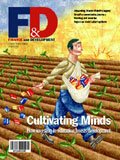 About F&D Subscribe Back Issues Write Us Copyright Information Free Email Notification Receive emails when we post new
items of interest to you. |
Five down, ten to go In 2000, the global community pledged at the UN Millennium Development Conference to achieve universal primary education (UPE) by 2015—one of eight goals that would represent a comprehensive reduction in global poverty. Five years later, only East Asia and the Pacific, and Latin America and the Caribbean are close to achieving the UPE goal, and sub-Saharan Africa, home to many of the world´s poor, lags far behind. What´s holding up progress? This issue of F&D takes stock of the enormous gains on the educational front over the past century and examines what needs to occur now for education for all to become a reality. We begin with the results of a just finished multi-year project for the American Academy of Arts and Sciences on universal basic and secondary education. The project co-directors, Joel Cohen (Rockefeller and Columbia Universities) and David Bloom (Harvard University), consider the additional cost of reaching UPE by 2015—estimates range from $6 billion to $35 billion per year—not only affordable but essential for providing economic benefits, building strong societies and polities, and improving health. They also emphasize that reaching UPE is about a lot more than money: many of the chief obstacles lie in the political, cultural, informational, and organizational domains. And they insist this goal isn´t ambitious enough. "The world should aim for, and can achieve, high-quality, universal secondary education, possibly by 2015 but certainly by the middle of the 21st century." F&D´s education issue also looks at the importance of achieving high-quality education for future economic and social gains—although the rate of uptake of well-established ways of improving schooling remains uncomfortably low. And we explore the successes emerging from India´s quiet revolution in elementary education, the need for sub-Saharan Africa to shift its focus from increasing admissions to reducing dropout rates and improving learning outcomes, how policymakers can create budget space for social outlays and make these outlays efficient, how tertiary education can be funded, and how foreign aid can be made smarter. Several F&D contributors argue that aid must be given in cycles of 5 years, rather than 2 years, and suggest that adopting incentives based on results could boost aid´s effectiveness. * * * * * In Straight Talk, IMF Chief Economist Raghuram Rajan tackles one of the hottest issues in international economic circles: how to craft an optimal debt relief proposal for low-income countries. He says that the proposals currently on the table have a one-size-fits-all flavor, but this is unfortunate because "one-size-fits-all proposals, while politically more convenient, are unlikely to benefit recipient countries as much as proposals that tie debt relief and additional aid to a country´s specific situation"—such as whether the government is corrupt and whether it has access to private markets. Incidentally, his previous column on odious debt has generated some strong reactions: see our Letters section. In People in Economics, we profile Mario Monti, an Italian professor and new think-tank head, who became a prominent European Union Competition Commissioner—known for his clashes with General Electric and Microsoft over issues of market power. Laura Wallace
|